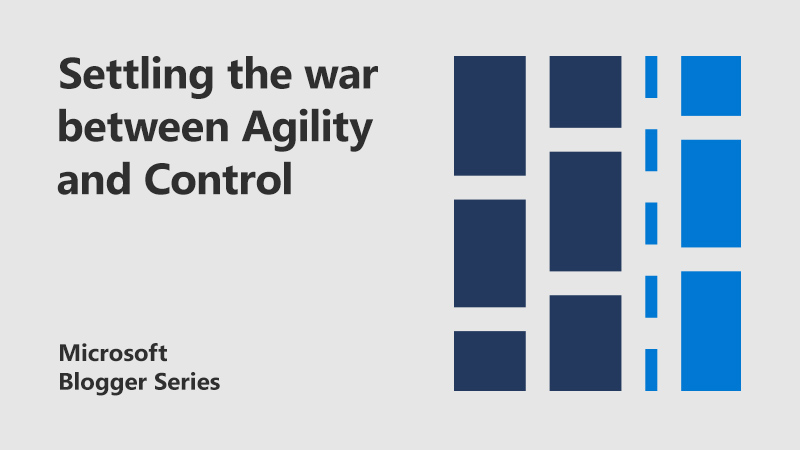
The Microsoft Cloud Adoption Framework for Azure: Settling the six-decade war between Agility and Control
Agility and control. Diametrically opposing forces present in almost every organisation in the world. Business leaders keen to innovate and disrupt the markets they operate in. Technical and IT leaders worried about security, governance, and availability. Both valid behaviours and concerns. Both totally incompatible with one another. Until now.
Ever since the first commercial emergence of mainframes in the 60s – generation 1 IT – the battle lines between IT and ‘the business’ had been drawn and the war between innovation and governance has waged without respite. Informing and achieving change in the early days of IT was glacially slow, and hellishly expensive. Control was managed by men (and the odd woman) in white coats behind locked doors who appeared to speak a foreign language. If the business were lucky, very lucky, they eventually got some of what they wanted, 6 months after they wanted it, and far too late for it to be of any use.
1960s |
Advent of the first commercial mainframes |
|---|---|
1980s |
Launch of the Windows PC and Microsoft’s gen 2 distributed computing model |
1990s |
Distributed IT models become more complex and uncoordinated |
Y2K |
Total Cost of Ownership’s benefit becomes damaged |
2000s |
The dot-com bubble booms… then bursts |
2003 |
IT is seen as a necessary but misunderstood evil |
2010s |
Best practice for IT Operating Model becomes broadly accepted |
Today |
Introduction of the Digital Operating Model, linking the IT Operating Model and Business Operating Model |
Introducing… |
Microsoft Cloud Adoption Framework for Azure |
Newfound freedoms
The Windows PC, and with it Microsoft’s generation 2 distributed computing model of the 80s, initially saw the battle swing wildly in the favour of Agility. The businesspeople celebrated their newfound freedom with the rampant and unbridled spread of Access databases, Excel spreadsheets, and personal laser printers. The IT people sulked, pining for the days of the dominance of control. Business had agility, but now realised they needed help. No-one was happy.
By the early 1990s, this distributed IT model (and its associated, often devolved IT budgets) had resulted in a somewhat out-of-control and completely un-coordinated IT function. You could easily call it chaos. Data could be found (and lost) everywhere; duplication and waste were rife; complexity exploded; never-ending technical refresh became the norm; and unreliable and badly deployed IT became commonplace.
Total cost of ownership
To aid the plight of the miserable Head of IT, and to help put a name to his or her pain, Gartner Group famously coined the Total Cost of Ownership (TCO) model to put some metrics around the concept of “hidden” IT costs, and so a move toward centralising the management of the organisation’s IT investments began. Slowly but surely, security and risk arguments and spiralling costs led to “best practice” IT operating models, and the tensions of a hampered agility returned. Superficially, there was peace, but the relationship was dysfunctional, and at times even adversarial.
The turn of the millennium inspired the massively expensive, red herring, no-material-benefit-achieved, IT-centred hype-storm known as Y2K. The sage commercial wisdom and credibility that the TCO concept had begun to help build for IT in the eyes of the business was damaged. Hot on the tail of Y2K, came a second IT-driven hype storm promising to the business-people massive changes to the entire way we do business, a gold rush of instant fortune – but in an instant, the “dot-com” bubble had boomed and burst. IT’s last shreds of credibility, and a decade of its future potential budgets, evaporated.
Us vs. them
As a result of the earlier rampant uncontrolled demand, the loss of trust in IT and its associated TCO centric expenditure management model, the IT function was sentenced to reside in the “central services” half of the organisation chart, alongside the HR, Operations, Legal and Accounting teams, and firmly in the Cost Centre columns of the accounts that the latter maintained and closely scrutinised. IT spend was perpetually under pressure, controlling priorities for satiating demand was often IT’s problem, and IT’s lack of responsiveness or ability to meet all demand was often cited as the reason for a given business’ lack of success against competitors.
An “Us and Them” culture had again emerged, and since around 2003 IT had found itself largely being seen as a necessary yet misunderstood evil, while the consumer market’s appetite for technology seemed to know no bounds.
But against this backdrop, over the past 15 or so years, things in the marriage have gradually improved. Our ideas of best practice for an IT Operating Model that works for the business too have solidified and become broadly accepted by consensus. Life has improved, and IT is again more valued than it was in the dark millennial days, but something was still not optimal. Today, we find that all the process and procedure to coordinate this fragile working relationship takes a considerable amount of effort and time. And all the while, the speed of change in the business market is accelerating around us.
Dreaded disruptors
The lunch of the huge dominant incumbent market forces is suddenly being eaten by the dreaded “disrupters” – and entirely new business models are changing the macroeconomic landscape seemingly overnight. These new businesses can scale massively in no time because of the availability of the apparently bottomless availability of ‘Pay as You Grow’ cloud. But it’s more than even just that. These new business models are almost entirely enabled – and are often completely created by – the innovative development of new applications of technology.
The business, having for many years labelled corporate IT as an overhead that needed to be delivered as cost effectively as possible, sat up and realised that the opposite was now true. IT could be their saviour and something to covet, not something to despise.
And at the exact same time, the corporate IT guys realised that a ‘good, but not great’ corporate IT Operating Model (ITOM) that has been controlling a carefully centrally managed ‘Buy and Build’ IT platform was too just slow to provide the agility that the business need for their Business Operating Model (BOM) to be competitive.
Both business and IT both seemingly arrived at the same destination. That they needed a new ‘OM’. One that linked an ITOM with a BOM more tightly allowing the best of agility and control. This new operating model we describe as a DOM. A Digital Operating Model. Powered by the cloud.
The digital operating model
So, where does our story take us from here? If we accept that organisations need a new kind of operating model. A digital operating model. How does one go about creating such a thing?
The answer is the Microsoft Cloud Adoption Framework for Azure. Following a structured and methodical framework is the best way for you to achieve this ambition. Covering everything from Strategy, Planning, Readiness, Migration, Innovation through to Governance, Management, and Operation, it’s the most detailed and most comprehensive cloud adoption framework ever written.
Do you want to discover what the Cloud Adoption Framework for Azure is and how it can help your business create a digital operating model to once and for all settle the battle between agility and control?
Book your place at one of my sessions at Future Decoded.
How to design a methodology for adopting and governing the cloud
01 Oct 11:30 – 12:30 | L3 Session Room 7
01 Oct 14:30 – 15:30 | L3 Session Room 8
02 Oct 14:00 – 15:00 | L3 Session Room 8
Also, keep your eyes peeled for a new book “Thinking of Building a Digital Operating Model with the Microsoft Cloud Adoption Framework?” written by myself and three colleagues, which is launching at Microsoft Ignite in November.
You can also explore more about the Microsoft Cloud Adoption Framework for Azure – from getting started to becoming fully operational in the cloud. You’ll find tools, guides, and narratives designed to help you identify business outcomes that will ease your adoption journey.
Find out more
Watch Dan’s session from Future Decoded
About the author
 Dan Scarfe is the UK Founder and EVP Global Solutions for Microsoft UK’s Partner of the Year New Signature. Dan is part of the global strategy and portfolio function, which sets forward direction, product and service definition and go to market activities globally. This work has included envisioning and launching New Signature’s FY20 GTM. Dan is well known for his subject matter expertise around the Microsoft Cloud, with operating models and the Microsoft Cloud Adoption Framework as specialist subjects. He sits on the global Azure Partner Advisory Council and is the author of two books. A technologist at heart, there is nothing Dan likes more than talking in front of people extolling the virtues of how technology can deliver meaningful impact to help organisations around the world go digital.
Dan Scarfe is the UK Founder and EVP Global Solutions for Microsoft UK’s Partner of the Year New Signature. Dan is part of the global strategy and portfolio function, which sets forward direction, product and service definition and go to market activities globally. This work has included envisioning and launching New Signature’s FY20 GTM. Dan is well known for his subject matter expertise around the Microsoft Cloud, with operating models and the Microsoft Cloud Adoption Framework as specialist subjects. He sits on the global Azure Partner Advisory Council and is the author of two books. A technologist at heart, there is nothing Dan likes more than talking in front of people extolling the virtues of how technology can deliver meaningful impact to help organisations around the world go digital.




